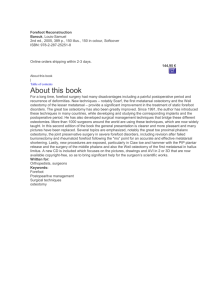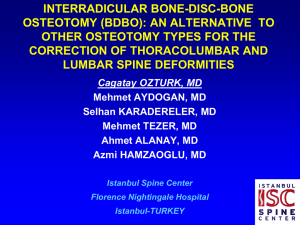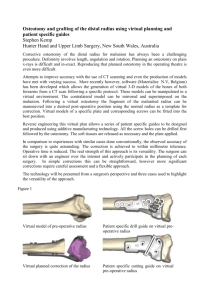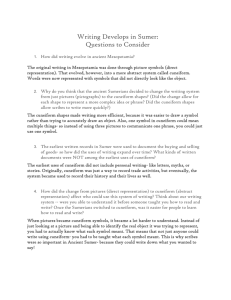20 Cuneiform Osteotomy FRANCIS LYNCH
advertisement
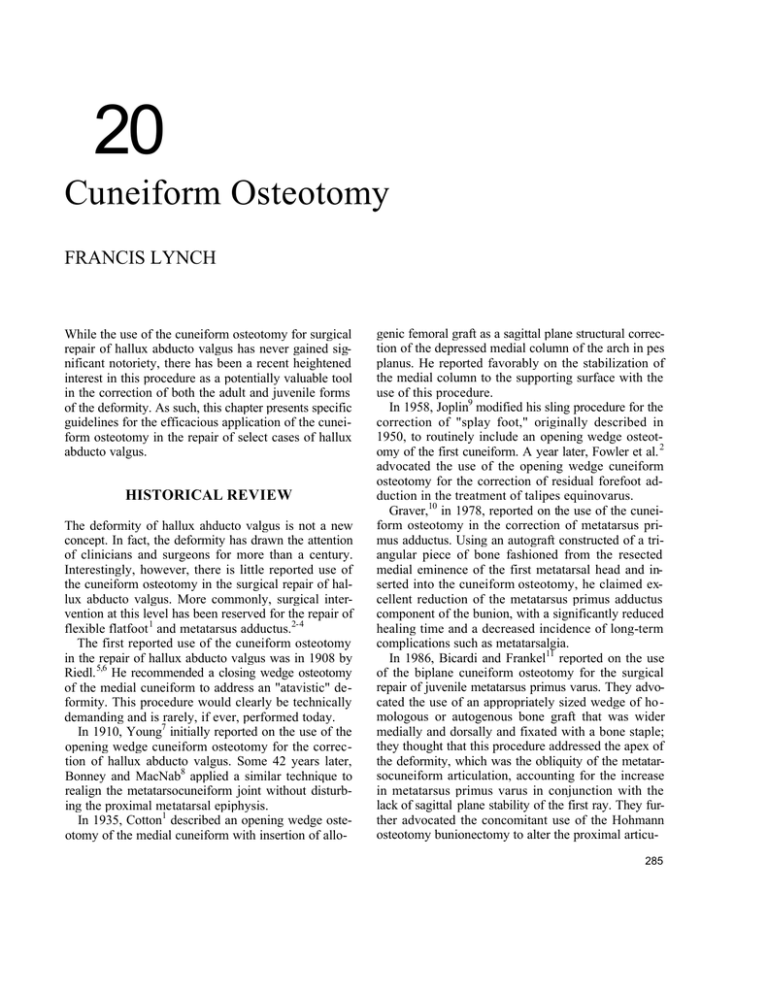
20 Cuneiform Osteotomy FRANCIS LYNCH While the use of the cuneiform osteotomy for surgical repair of hallux abducto valgus has never gained significant notoriety, there has been a recent heightened interest in this procedure as a potentially valuable tool in the correction of both the adult and juvenile forms of the deformity. As such, this chapter presents specific guidelines for the efficacious application of the cuneiform osteotomy in the repair of select cases of hallux abducto valgus. HISTORICAL REVIEW The deformity of hallux ahducto valgus is not a new concept. In fact, the deformity has drawn the attention of clinicians and surgeons for more than a century. Interestingly, however, there is little reported use of the cuneiform osteotomy in the surgical repair of hallux abducto valgus. More commonly, surgical intervention at this level has been reserved for the repair of flexible flatfoot 1 and metatarsus adductus.2-4 The first reported use of the cuneiform osteotomy in the repair of hallux abducto valgus was in 1908 by Riedl. 5,6 He recommended a closing wedge osteotomy of the medial cuneiform to address an "atavistic" deformity. This procedure would clearly be technically demanding and is rarely, if ever, performed today. In 1910, Young7 initially reported on the use of the opening wedge cuneiform osteotomy for the correction of hallux abducto valgus. Some 42 years later, Bonney and MacNab8 applied a similar technique to realign the metatarsocuneiform joint without disturbing the proximal metatarsal epiphysis. In 1935, Cotton1 described an opening wedge osteotomy of the medial cuneiform with insertion of allo- genic femoral graft as a sagittal plane structural correction of the depressed medial column of the arch in pes planus. He reported favorably on the stabilization of the medial column to the supporting surface with the use of this procedure. In 1958, Joplin9 modified his sling procedure for the correction of "splay foot," originally described in 1950, to routinely include an opening wedge osteotomy of the first cuneiform. A year later, Fowler et al. 2 advocated the use of the opening wedge cuneiform osteotomy for the correction of residual forefoot adduction in the treatment of talipes equinovarus. Graver,10 in 1978, reported on the use of the cuneiform osteotomy in the correction of metatarsus primus adductus. Using an autograft constructed of a triangular piece of bone fashioned from the resected medial eminence of the first metatarsal head and inserted into the cuneiform osteotomy, he claimed excellent reduction of the metatarsus primus adductus component of the bunion, with a significantly reduced healing time and a decreased incidence of long-term complications such as metatarsalgia. In 1986, Bicardi and Frankel11 reported on the use of the biplane cuneiform osteotomy for the surgical repair of juvenile metatarsus primus varus. They advocated the use of an appropriately sized wedge of homologous or autogenous bone graft that was wider medially and dorsally and fixated with a bone staple; they thought that this procedure addressed the apex of the deformity, which was the obliquity of the metatarsocuneiform articulation, accounting for the increase in metatarsus primus varus in conjunction with the lack of sagittal plane stability of the first ray. They further advocated the concomitant use of the Hohmann osteotomy bunionectomy to alter the proximal articu285 286 HALLUX VALGUS AND FOREFOOT SURGERY lar set angle (PASA) by realigning the adapted articular cartilage of the first metatarsal head, and also recommended that the capital fragment be transposed laterally for additional intermetatarsal angle correction, and plantarly, to overcome the elevation of the first metatarsal that is often seen with a hypermobile first ray. Bicardi and Frankel believed that this procedure preserved the length of the first metatarsal, and by increasing the height of the distal-medial arch and the forward inclination of the metatarsocuneiform joint in the sagittal plane, enhanced the durability of correction against recurrence from continued pronatory stress in the flatfoot. Using pre- and postoperative electrodynagraphy (EDG), Bicardi and Frankel noted significant alterations in the weight-bearing of the forefoot postoperatively. Interestingly, the first metatarsal bore weight relatively earlier in the stance phase of gait and also loaded to a greater extent than preoperatively. They were also impressed with the overall reduction and alignment of the first metatarsophalangeal joint (MPJ). As such, the authors concluded that this particular technique was superior for intermetatarsal angle reduction and realignment of the first metatarsocuneiform joint. INDICATIONS The following represent indications for the use of the cuneiform osteotomy in the repair of hallux abducto valgus: 1. Structural increase in the first intermetatarsal angle or metatarsus primus adductus as a result of atavism or increased obliquity of the distal articular facet of the medial cuneiform 2. Absence of deformity of the first metatarsal proper—no hyperadduction of the long axis of the first metatarsal relative to its base 3. Medial column adductus with or without concomitant metatarsus primus adductus 4. Hypermobility of the first ray with resultant elevatus and instability 5. Patient displaying appropriate degree of maturity of the medial cuneiform (age 6 and older) (Fig. 20-1) Fig. 20-1. This 25-year-old white woman with advancing hallux valgus displays classic radiographic findings that suggest the efficacious applicability of cuneiform osteotomy. Note the increased intermetatarsal angle as a result of structural deformity in the distal articular facet of the cuneiform with absence of deformity within the first metatarsal proper. There is also accompanying medial column adductus of 25°. CUNEIFORM OSTEOTOMY 287 EFFECTS The following are considered primary effects of the cuneiform osteotomy when applied to the correction of hallux abducto valgus (Fig. 20-2): 1. Reduction in the obliquity of the distal articular facet of the medial cuneiform 2. Reduction of metatarsus primus adductus 3. Reduction of medial column adductus (juvenile patient) Fig. 20-2. (A) Preoperative and (B) postoperative radiographs reveal reduction in obliquity of the distal articular facet of the medial cuneiform, metatarsus primus adductus, and medial column adductus as a result of performance of the biplane cuneiform osteotomy. Accentuation of the PASA and lengthening of the first ray have been accommodated bv bicorrectional first metatarsal head osteotomy. 288 HALLUX VALGUS AND FOREFOOT SURGERY 4. Plantar flexion of the first ray 5. Lengthening of the first ray 6. Accentuation of PASA deformity of the first MPJ SURGICAL TECHNIQUES AND APPLICATIONS The cuneiform osteotomy is reserved for the older child and adult. In children much less than the age of 6 years the ossification of the first cuneiform has not proceeded to an extent that would allow appropriate dissection and osteotomy at this level. 3 It is imperative that the surgical procedure be carried out in a certain manner for optimal benefit. The sequence of steps in the performance of the procedure are as follows: 1. Complete release of the first MPJ. 2. Biplane cuneiform osteotomy with grafting and fixation. 3. Transpositional, PASA-realigning, and first metatarsal-shortening osteotomy as necessary. 4. Adductor tendon transfer, capsulorrhaphy, and concomitant rebalancing of the first MPJ as deemed appropriate. 5. Performance of ancillary surgical procedures deemed necessary for the overall elimination of associated pedal pathology. This may include lengthening of the achilles tendon, gastrocnemius recession, surgical repair of flexible flatfoot, or additional adjunctive repair of metatarsus adductus. The surgeon should first direct his attention to the first MPJ. The short extensor tendon is tenotomized and the long extensor tendon is lengthened in a sliding or open Z fashion if this structure is taut or displaced laterally to the long axis of the first MPJ. The adductor tendon is freed from the lateral aspect of the base of the phalanx and fibular sesamoid. In cases in which there is a significant lateral deviation of the sesamoids relative to the first metatarsal head and repositioning is deemed appropriate,12 or when preoperative evaluation suggests additional positional abnormality of the first metatarsocuneiform joint,13 the adductor tendon is tagged for later transfer (Fig. 20-3). A lateral capsulotomy is performed and a medial inverted J-shaped capsulotomy is carried out. Fig. 20-3. Adductor tendon transfer is an important adjunctive maneuver in the overall repair of hallux abducto valgus, serving to reposition the sesamoid apparatus beneath the first metatarsal head and to reduce positional increase in the first intermetatarsal angle. At this point the first MPJ is considered appropriately released, and further surgical intervention at this level is delayed until the effects of the cuneiform osteotomy can be appreciated. Incision planning for the cuneiform osteotomy is of paramount importance. The two landmarks that are most helpful in this process are the tibialis anterior and extensor hallucis longus tendons. Mapping their course, the surgeon can then plan an incision overlying the substance of the medial cuneiform approximately two-thirds of the way from the tibialis anterior to the extensor hallucis longus tendon. Few anatomic structures are encountered in dissection from the subcutaneous tissue through to the periosteum overlying the cuneiform. A longitudinal periosteal incision is made, and subperiosteal dissection is carried out exposing the dorsal and medial aspects of the medial cuneiform. The osteotomy is then created within the substance of the medial cuneiform. Two variations of this osteot- CUNEIFORM OSTEOTOMY 289 omy have been used to date and warrant some degree of explanation. When the primary transverse plane deformity is metatarsus primus adductus and there is minimal medial column adductus, or in instances in which a moderate amount of medial column adductus exists with or without additional metatarsus primus adductus in the juvenile foot displaying relative lack of maturity of the lesser metatarsocuneiform articulations, the osteotomy is created approximately 1.0—1.5 cm proximal and parallel to the distal articular facet of the first cuneiform (Fig. 20-4). In instances in which the predominant deformity is medial column adductus with minimal metatarsus primus adductus, and the foot shows maturity at the lesser metatarsocuneiform articulations, the osteotomy must be varied somewhat. In this case, the osteotomy is begun at the midpoint of the medial cuneiform and directed proximal and lateral toward the cuboid. This variation allows the surgeon to continue the cut through the second or third cuneiform bones to allow for optimal abduction of the medial column with avoidance of the second metatarsal base. Although the osteotomy performed in this manner will have less Fig. 20-4. Placement of the cuneiform osteotomy just proximal and parallel to the distal articular facet of the medial cuneiform will result in maximal reduction of cuneiform obliquity and intermetatarsal angle. Further, a "domino effect" is observed in the juvenile foot, resulting in significant reduction of medial column adductus. (Courtesy of J.V. Ganley. D.P.M., Norristown, PA.) Fig. 20-5. Placement of the cuneiform osteotomy, beginning at the midpoint of the medial cuneiform and extending through the second or third cuneiforms, is indicated in the mature foot with minimal metatarsus primus adductus, but significant medial column adductus. (Courtesy of J.V. Ganley, D.P.M.) 290 HALLUX VALGUS AND FOREFOOT SURGERY direct effect on the first intermetatarsal angle proper, it has better ability overall to abduct the entire medial column when this surgical maneuver is deemed of primary importance (Fig. 20-5). With the osteotomy held open the desired amount, an allogenic corticocancellous graft of appropriate proportions is created and inserted. This graft should be wider dorsally and medially to allow for plantar flexion of the medial column in conjunction with the transverse plane correction. The graft is then secured with Kirschner wire (K-wire) or power staple fixation and remodeled as necessary. Once the cuneiform osteotomy and grafting have been carried out, a sponge is placed over the surgical site and attention is directed back to the first MPJ. The degree of correction of the intermetatarsal angle and medial column adductus can now be appreciated, and the necessity for any further lateral transposition of the first metatarsal head, shortening of the first metatarsal to prevent jamming of the first MPJ, and degree of correction of the PASA for overall better alignment and function of the first MPJ can be evaluated. To this extent, most cases will require a PASA realigning, Fig. 20-6. Concomitant first metatarsal head osteotomy for realignment of the PASA and decompression of the first MPJ is usually required in conjunction with cuneiform osteotomy for overall optimal alignment of the first MPJ. transpositional, and shortening first metatarsal head osteotomy that will complete the structural correction (Fig. 20-6). If it is deemed appropriate to perform adductor tendon transfer to decrease positional deformity of the first metatarsocuneiform joint or to help in the realignment of the sesamoid apparatus, it should be carried out at this time. When the procedure has been appropriately performed, examination of the foot before final closure and application of the postoperative dressing will reveal the following (Fig. 20-7): 1. The concavity of the medial aspect of the foot has disappeared. 2. The alignment of the first MPJ is optimal. 3. The first ray is in a rectus to slightly plantar-flexed position relative to the lesser metatarsals. 4. The range of motion of the first MPJ is full and is noted not to jam or track back into the abducted position with dorsiflexion. Fig. 20-7. Postoperative photograph showing overall improvement in contour of the entire forefoot and alignment of the first MPJ after performance of the cuneiform and first metatarsal head osteotomies. CUNEIFORM OSTEOTOMY 291 ANCILLARY SURGICAL PROCEDURES On occasion, it is necessary to perform adjunctive surgical procedures to eliminate additional structural pathology. As such, the correction of equinus, flatfoot, and significant residual lateral column adductus may be required.12 If preoperative assessment reveals significant contracture of the gastrocnemius or triceps surae complex, then appropriate Achilles tendon lengthening or gastrocnemius recession should be carried out in conjunction with repair of the primary deformity. In individuals with significant flexible flatfoot whose control postoperatively is tenuous, surgical repair of the flatfoot must be considered. A significant, uncontrollable flatfoot should undergo realignment and stabilization of the rearfoot to eliminate a primary deforming force from continuing its destructive input at the level of the first MPJ postoperatively. Significant pan metatarsus adductus, while a rare finding, does on occasion exist and may require addi tional surgical technique. In addition to the cuneiform osteotomy, this particular foot may require closing wedge osteotomy of the cuboid for overall alignment of the foot and better long-term function14 (Fig. 20-8). Finally, the repair of lesser digital deformities and rebalancing of lesser MPJs, or metatarsal osteotomies, should be carried out to correct the secondary deformities as the result of advancing hallux valgus as deemed necessary. POSTOPERATIVE CARE At the time of surgical repair, a compression dressing and posterior splint are applied holding the corrected components in their appropriate position. This splint should allow the first ray to be held in the slightly plantar-flexed position with optimal alignment of the first MPJ in the transverse plane. Further, the ankle should be kept at a right angle to the leg to prevent contracture of the flexor hallucis longus in the early stages of recovery, which could cause restriction of dorsiflexion of the first MPJ in the long run. The importance of early mobilization and range of motion of the first MPJ cannot be overstated. The immediate use of continuous passive motion (CPM) to Fig. 20-8. Performance of the closing wedge cuboid osteotomy in conjunction with cuneiform osteotomy is indicated in patients with significant lateral column adductus. (Courtesy of J.V. Ganley, D.P.M.) encourage appropriate range of motion of the first MPJ postoperatively should be entertained.15 The sutures are removed in 14 days, and the splint is converted to a below-knee cast until 6 weeks from the date of surgery have elapsed. During this entire period, weight-bearing is not permitted and range-ofmotion exercises are strongly encouraged. When the patient begins weight-bearing postoperatively, it should be in a rigid orthotic that affords significant midfoot and rearfoot control with maximal intrinsic forefoot posting, to encourage the first ray to maintain its plantargrade position in the sagittal plane and to remove the deforming forces from the MPJ that may exist postoperatively as a result of continued anteromedial imbalance. 292 HALLUX VALGUS AND FOREFOOT SURGERY POTENTIAL COMPLICATIONS OF CUNEIFORM OSTEOTOMY The following are the most common potential complications that may arise as a result of the cuneiform osteotomy: 1. The procedure may be made difficult by the presence of the tibialis anterior tendon, which traverses the operative field. This, however, is rarely a significant problem and the tendon sheath may be opened and tendon reflected with later repair without significant alteration of the overall surgical outcome. 2. The procedure requires bone grafting, which potentially introduces a separate set of complications. Realistically, however, there has been little problem with the use of allogenic bone graft. It rapidly incorporates into the osseous system of the host with minimal complications. To date there has been only one delayed union that went on to eventual healing with the use of electrical bone stimulation and immobilization. There have been no rejections. 3. That part of the osteotomy bridged by the graft may heal more slowly. This, again, has not been noted, and in fact with the use of allogenic bone graft and power staple fixation, this area seems to be afforded tremendous stability with rapid incorporation and healing. 4. Soft medullary bone is more inclined to collapse with loss of correction. This event is conceivable but has not been observed to happen in this author's experience. The use of the power staple fixation and properties of allogenic graft incorporation prevent this deleterious event from occurring. 5. While graft extrusion may occur, it has not been noted to date by the author. Appropriate fashioning, placement, and fixation will eliminate this potential complication. 6. The surgeon may accidentally osteotomize the second metatarsal base. This can be avoided by leaving the lateral cortex of the medial cuneiform intact and "green-sticking" it when the osteotomy is opened. 7. The patient may experience insertional tendonitis of the anterior tibial tendon. While this has oc- curred on several occasions, it has been only transitory. Appropriate graft remodeling and fixation placement in conjunction with atraumatic soft tissue dissection will reduce the possibility of this problem. 8. Osteotomy, or staple entrance, into the first metatarsocuneiform joint is possible, but this unfortunate occurrence may be eliminated by complete visualization of this joint before osteotomy or fixation. 9. Irritation of the skin overlying the cuneiform as a result of prominent internal fixation can be eliminated by the use of K-wire or reduced with appropriate staple placement. When staple irritation occurs, the staple can be removed with minimal disability. 10. Misalignment or jamming of the first MPJ may be eliminated with appropriate adjunctive first metatarsal osteotomy, which aligns the PASA and compensates for the lengthening that occurs as a result of the cuneiform osteotomy. SUMMARY The goal of hallux abducto valgus surgery is to create a well-aligned, pain-free joint while removing as many contributory etiologic factors causing misalignment of the first MPJ as possible. Retrospective analysis of both juvenile and adult hallux abducto valgus shows an intimate relationship of misalignment of the first MPJ with metatarsus primus adductus as a result of structural deformity of the distal articular facet of the medial cuneiform, medial column adductus, anterior medial instability of the first ray with elevatus, and varying degrees of flexible flatfoot. The cuneiform osteotomy is ideal for addressing the apex of the deformity, reestablishing a more transverse attitude to the distal articular facet of the medial cuneiform, and thus reducing the intermetatarsal angle and medial column adductus. Further, the first ray is stabilized in the sagittal plane and the anterior medial instability is improved. At the same time, postoperative complications are kept to a minimum and consistent and reliable realignment of the forefoot and MPJ deformity are attained. We do not present the opening wedge cuneiform osteotomy with adjunctive first MPJ rebalancing and metatarsal osteotomy as a panacea applicable to all CUNEIFORM OSTEOTOMY 293 foot types. However, in the appropriately applied clinical setting, a consistently reliable result can be attained, and modern podiatric surgeons must consider this procedure as a valuable addition to their surgical armamentarium. REFERENCES 1. Cotton F: J Foot statistics and surgery. Trans N Engl Surg Soc 18:181, 1935 2. Fowler B, Brooks AL, Parrish TF: The cavovarus foot. J Bone Joint Surg 41A:757, 1959 3. Hofmann AA, Constine RM, McBride GG, Coleman SS: Osteotomy of the first cuneiform as treatment of residual adduction of the fore part of the foot in club foot. J Bone Joint Surg 66A:985, 1984 4. Lincoln CR, Wood KE, Bugg El: Metatarsus varus corrected by open wedge osteotomy of the first cuneiform bone. Orthop Clin North Am 7:795, 1976 5. Helal B: Surgery for adolescent hallux valgus. Clin Orthop 157:50, 1981 6. Kelikian H: Hallux Valgus, Allied Deformities of the Forefoot and Metatarsalgia. WB Saunders. Philadelphia, 1965 7. Young JD: A new operation for adolescent hallux valgus. Univ Pa Med Bull 23:459, 1910 8. Bonney G, McNab I: Hallux valgus and hallux rigidus: a critical survey of operative results. J Bone Joint Surg 34B:366. 1952 9. Joplin RJ: Some common foot disorders amenable to surgery. Am Acad Orthop Surg 15:144, 1958 10. Graver HH: Cuneiform osteotomy in correction of metatarsus primus adductus. J Am Podiatry Assoc 68:111, 1978 11. Bicardi BE, Frankel JP: Biplane cuneiform osteotomy for juvenile metatarsus primus varus. J Foot Surg 25:472, 1986 12. Mahan KT, Yu GV: Juvenile and adolescent hallux valgus. p. 61. In McGlamry ED, McGlamry R (eds): Doctors Hospital Podiatry Institute Surgical Seminar Syllabus. Doctors Hospital Podiatric Education and Research Institute, Atlanta, 1985 13. Pressman MM, Stano GW, Krantz MK, Novicki DC: Correction of hallux valgus with positionally increased intermetatarsal angle. J Am Podiatr Med Assoc 76:611,1986 14. Grumbine N: Cuboid osteotomy. Seminar lecture, Baha Project, Los Angeles, 1986 15. Kaczander B: The podiatric application of continuous passive motion: a preliminary report. J Am Podiatr Med Assoc 81:631, 1991

